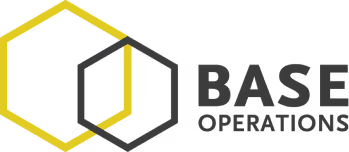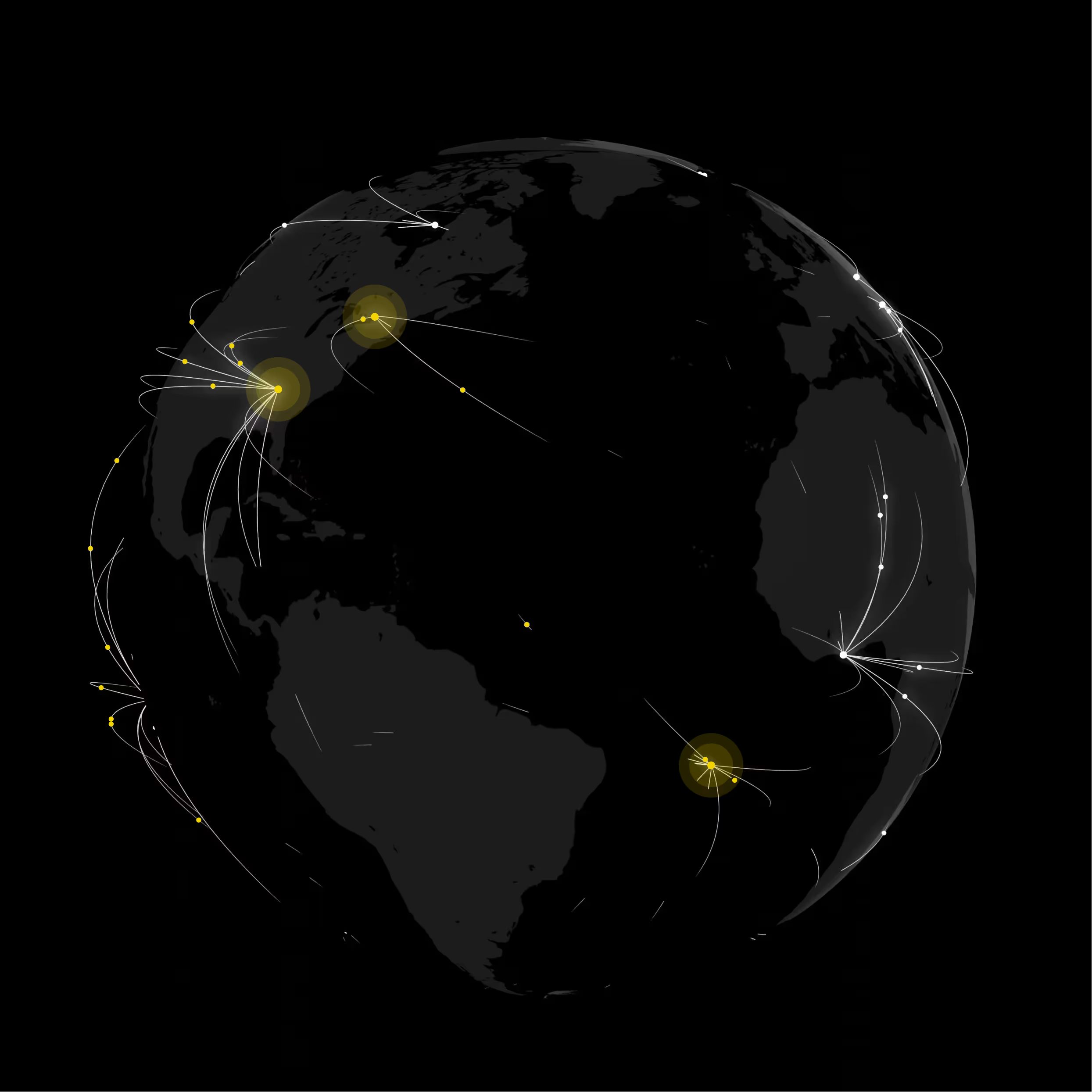
Fortune 500 Travel Company Scales Executive Protection Concierge Service
A leading global travel company's Risk Intelligence team expanded from reactive country-level assessments to proactive, location-specific executive protection and travel security across 300+ global destinations without increasing headcount.

300+ locations
$25k annual savings
Became trusted concierge
Challenge
Following multiple global reorganizations, the US-based Risk Intelligence team faced an expanded mandate covering executive protection, employee travel security for 15,000+ staff, and general risk intelligence—all without additional resources. The team relied on country or city-level geopolitical reporting and generic annual travel ratings that couldn't support prescriptive travel briefings or location-specific security recommendations for an expanded executive leadership team.
Solution
The Risk Intelligence team implemented Base Operations to deliver detailed crime insights at street-level precision for each executive travel location, including airports, lodging, offices, and dining establishments. This transformed their capability from reactive threat monitoring to proactive travel advisory, enabling security to function as a strategic concierge service rather than just an intelligence provider.
Results
The team assessed over 300 locations within the calendar year, delivering comprehensive travel security for employees internationally and new site assessments. They saved $25,000 annually while elevating security's organizational value from reactive reporting to trusted advisor status. Travel briefs evolved from high-level city summaries to in-depth, location-specific security recommendations aligned with executive preferences. This positioned security as an enabler of safe, informed travel decisions rather than a constraint.

The Expanding Mandate Without Expanding Resources
After a series of global reorganizations, the Risk Intelligence team at a Fortune 500 online travel company faced a challenge familiar to security leaders worldwide: significantly expanded responsibilities with no additional headcount. The US-based team now owned executive protection, employee travel security for over 15,000 staff, and risk intelligence for corporate offices spanning international markets.
But scope expansion revealed a deeper problem. Their existing intelligence approach—country or city-level geopolitical reporting paired with generic annual travel ratings—couldn't support the prescriptive guidance executives increasingly demanded. When leadership requested travel briefings, the team delivered manually compiled threat summaries based on outdated information rather than actionable recommendations about specific locations.
The stakes were particularly high for a company in the travel industry. Executives and employees traveled constantly, visiting unfamiliar markets to evaluate partnerships, assess operations, and meet clients. Generic country and city-level intelligence provided no insight into whether a specific hotel district was safe, which restaurants posed elevated risk, or how threat environments shifted between downtown business areas and airport corridors.

From Reactive Reporting to Proactive Advisory
The Risk Intelligence team's challenge wasn't just data access. It was organizational positioning. Security functioned as a reactive service, responding to requests for threat updates but unable to provide the granular, location-specific guidance that would earn them a seat at strategic discussions.
This limitation created three specific pain points. First, threat assessments lagged behind business decisions. By the time security completed research on a destination using scattered public sources and fragmented databases, executives had often already selected hotels or scheduled meetings. Second, inconsistent data quality across regions meant security couldn't confidently compare locations or make standardized recommendations. A "medium risk" assessment for one city carried different implications than the same rating for another.
Third, and most critically, the team couldn't demonstrate strategic value beyond crisis response. When executives asked about optimal lodging locations or safe dining options for client entertainment, security provided disclaimers rather than data-driven recommendations. The team's expertise in threat analysis wasn't translating into trusted advisory relationships.
The expanded mandate—covering executive protection, broad employee travel, and site assessments—only intensified these challenges. Manual research processes that consumed hours per destination simply couldn't scale to support 15,000+ employees and an executive leadership team expecting immediate, actionable intelligence.
Street-Level Intelligence as Strategic Enabler
The Risk Intelligence team implemented Base Operations to transform their operational model from reactive reporting to proactive advisory. The platform's street-level crime and threat data—covering airports, lodging districts, office locations, and dining establishments—enabled the team to answer the specific questions executives actually asked.
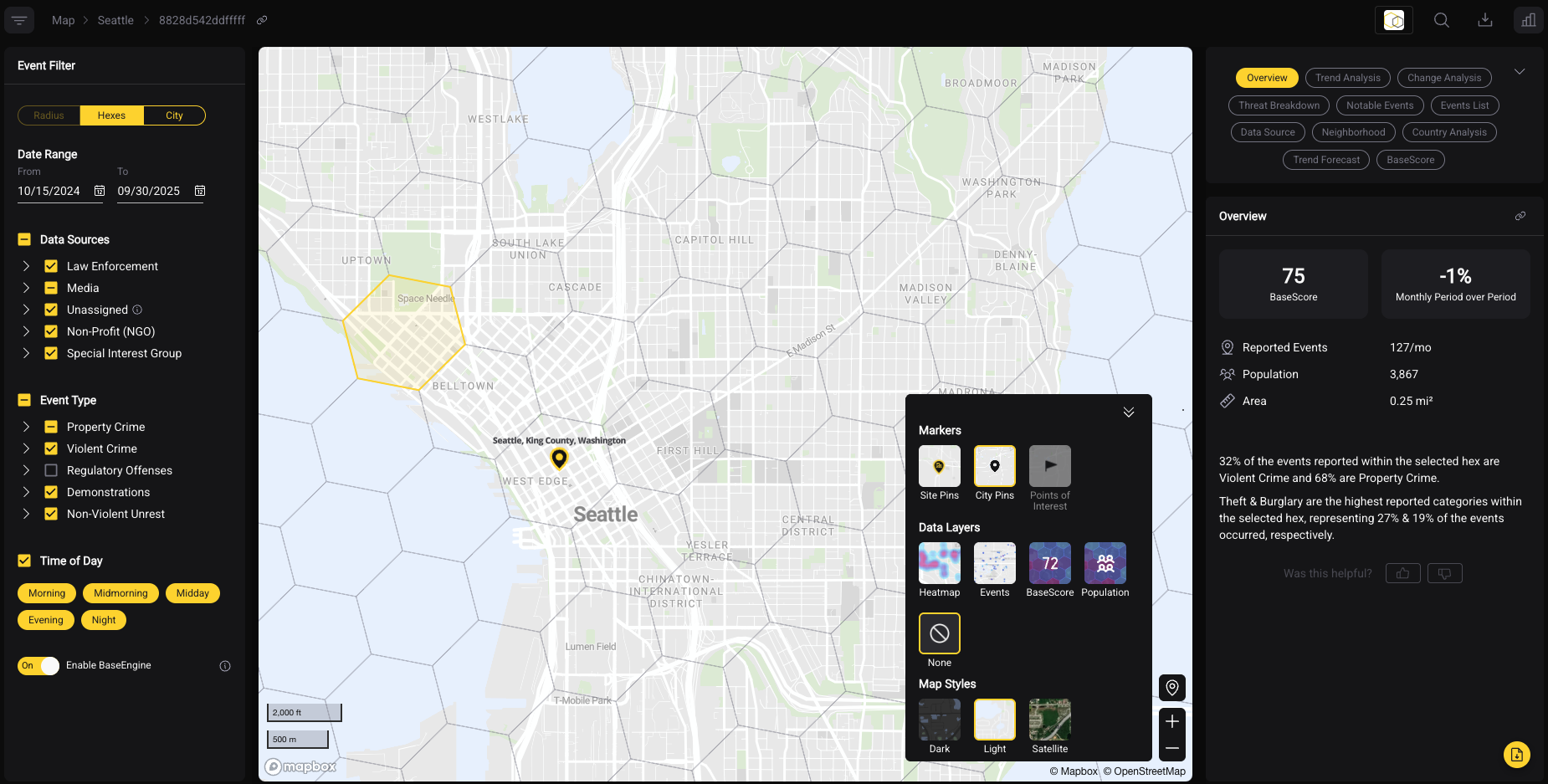
Instead of generic country briefs warning about elevated urban crime, security now delivered precise assessments: this hotel district experiences property theft concentrated during evening hours, while this restaurant cluster three blocks away shows minimal incident history. The granularity unlocked a new capability: providing positive recommendations, not just risk warnings.
Implementation happened rapidly. Within one week, analysts accessed detailed threat intelligence for destinations across their operational footprint. The platform's visualization tools—heatmaps showing incident concentration, temporal patterns revealing high-risk hours, and threat breakdowns identifying specific crime types—enabled analysts to quickly orient to unfamiliar locations.
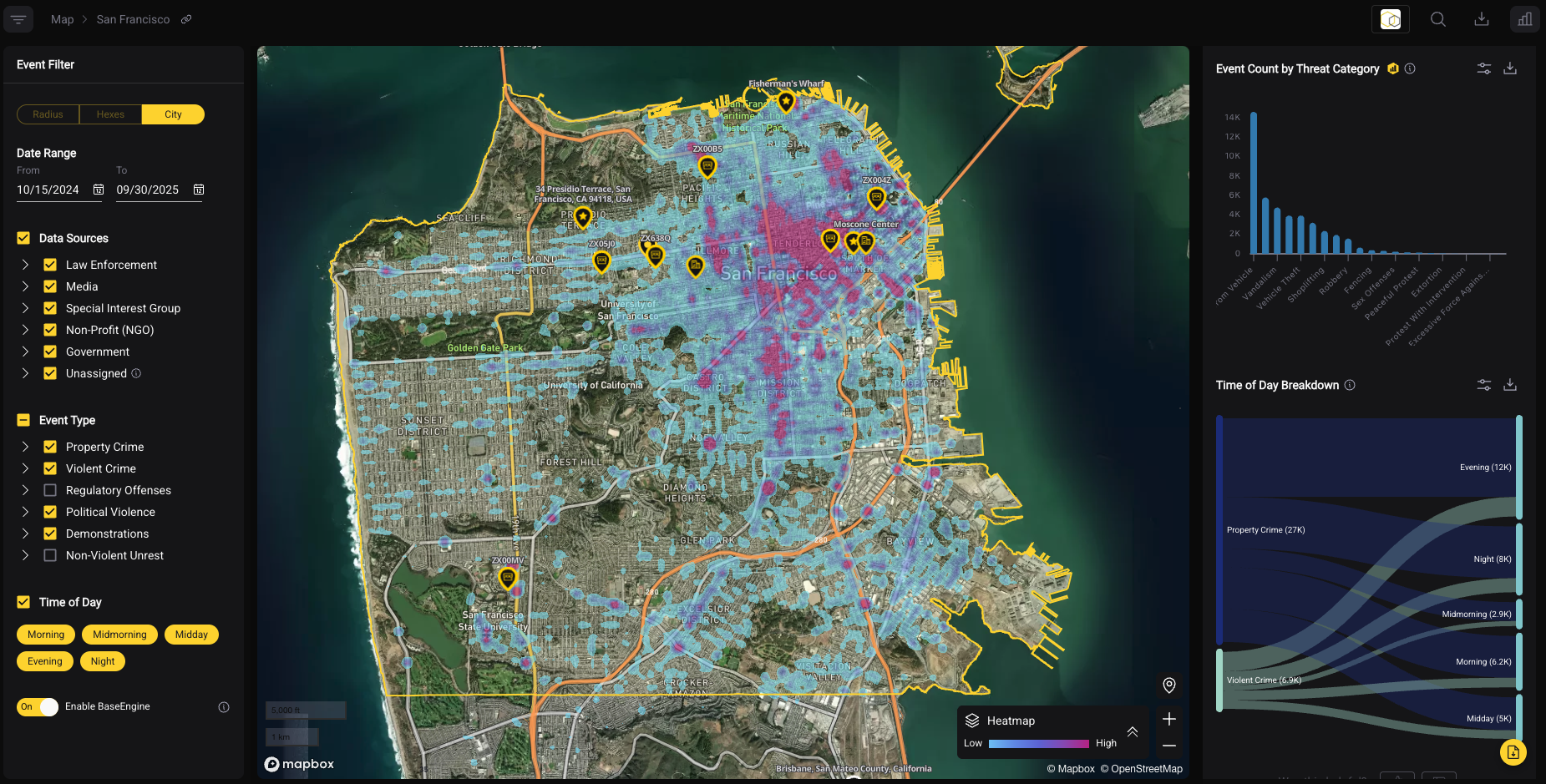
The team's workflow transformed completely. Previously, an analyst preparing an executive travel brief spent hours manually searching public crime databases, news sources, and State Department advisories to piece together a city-level assessment. Now that same analyst pulled comprehensive, standardized data in minutes, then invested their time on analysis: interpreting patterns, identifying safe corridors, and crafting location-specific recommendations aligned with executive preferences.
This workflow shift enabled the team to expand coverage dramatically. They assessed over 300 locations within the calendar year—supporting not just executive protection but also employee travel security for 15,000+ international staff and new site evaluations for corporate expansion. The platform's consistent data structure meant assessments maintained the same quality standards whether evaluating a major metropolitan hub or a secondary market with limited public information.
Most significantly, street-level precision transformed security's organizational role. When executives asked where to stay, the team confidently recommended specific hotel districts backed by quantified threat data. When planning client entertainment, security suggested restaurants in low-risk neighborhoods rather than issuing blanket cautions. The language shifted from "avoid downtown" to "this corridor shows favorable patterns compared to alternatives."
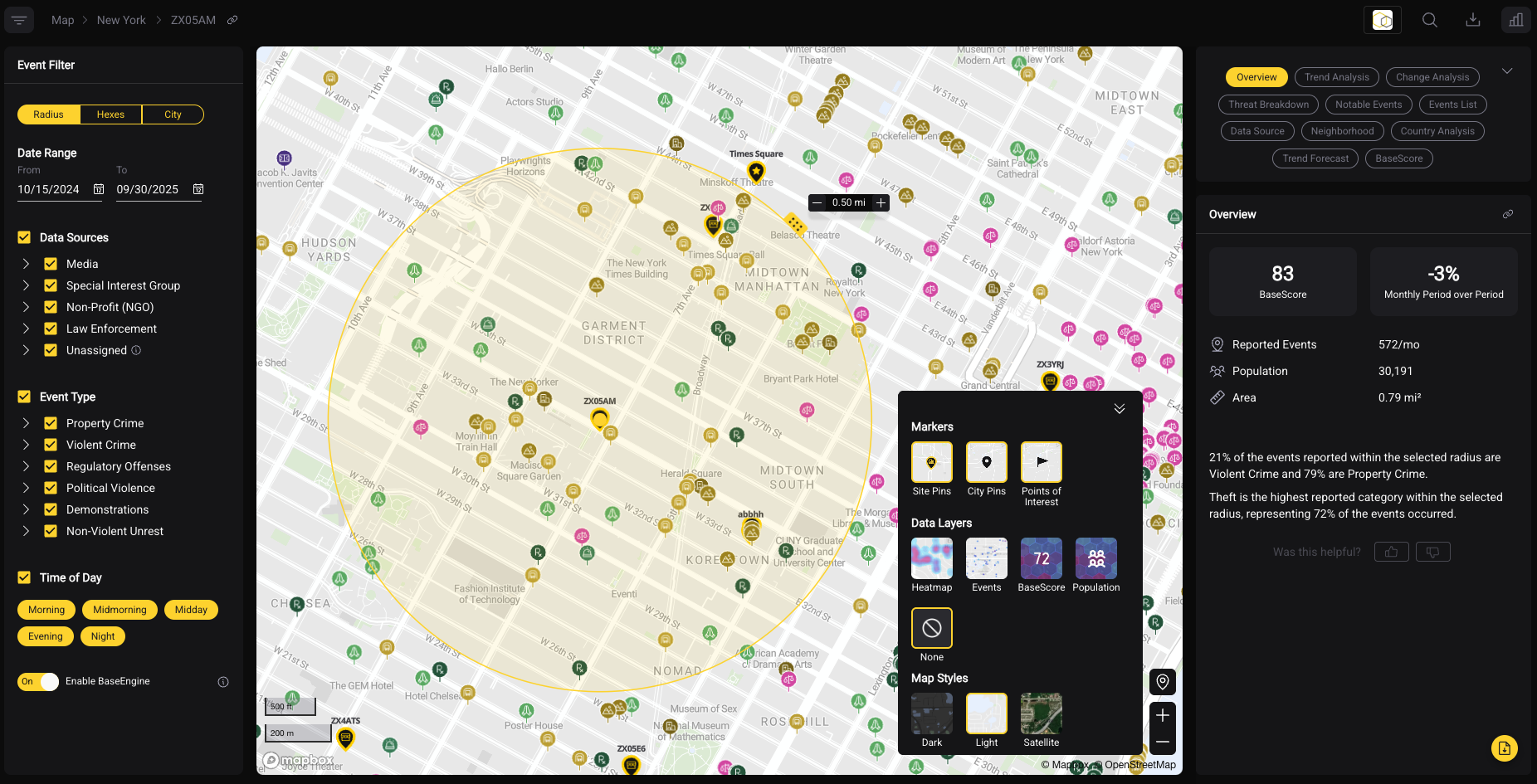
From Cost Center to Concierge Service
The team assessed 300+ locations within one calendar year while achieving $25,000 in annual cost savings compared to previous overhead costs. But the strategic transformation proved more valuable than the financial gains.
Travel briefs evolved from reactive city summaries to proactive, location-specific intelligence products. Instead of generic geopolitical overviews, security delivered tailored assessments addressing each executive's specific itinerary: threat profiles for their selected hotel, safe transportation routes, vetted dining options, and recommendations for client entertainment venues. Each brief incorporated executive preferences while maintaining rigorous safety standards.

This capability shift elevated security's organizational positioning. As one team member reflected: "Prior to Base Operations, our reporting was limited to country or city-level geopolitical analysis and annual travel ratings. Now granular reporting means we can make informed decisions on where to stay, where to eat, where to entertain. Security teams are no longer just relied on for the latest news reporting, but leveraged as a concierge for travel recommendations across lodging and client entertainment."
The concierge designation marked a fundamental change. Security transitioned from saying "no" to enabling "yes, with informed risk understanding." When executives evaluated new markets, security didn't block expansion—they identified the safest locations within those markets. When employees traveled internationally, security didn't issue blanket warnings—they provided specific guidance enabling safe, confident operations.
The expanded mandate that initially seemed impossible became manageable without additional headcount. The team supported executive protection, employee travel security for 15,000+ staff, corporate site assessments, and new market evaluations. All of this while improving response times and intelligence quality. Base Operations freed analysts from manual data gathering, enabling them to focus on high-value interpretation and strategic recommendations.
The $25,000 annual savings, while meaningful, understated the total value. By enabling security to function as trusted advisors rather than reactive reporters, the platform positioned the team as strategic enablers of business growth.
Scaling Strategic Impact
The Risk Intelligence team continues expanding their use of Base Operations across new use cases. Beyond executive protection and employee travel, they're applying street-level intelligence to evaluate potential office locations, assess vendor facilities, and conduct due diligence for partnership discussions.
The platform's global coverage positions security to support business expansion confidently. When leadership identifies new market opportunities, security delivers comprehensive threat assessments within hours rather than weeks, enabling faster strategic decisions backed by consistent risk analysis.
Most importantly, security maintains their newly established role as trusted concierge advisors. Executives don't view security briefings as obstacles—they request them as valuable intelligence informing smarter travel decisions. This relationship transformation represents the platform's most significant impact: elevating security from reactive cost center to proactive strategic advantage enabling safe global operations.
Related Case Studies

Leading AI Provider Delivers Executive Protection Assessments 3x Faster and Uncovers 25% More Threat Insights
Fast-growing AI company builds a data-driven executive protection program using street-level threat intelligence and AI-enhanced analysis to protect rapidly expanding C-suite across global operations.
